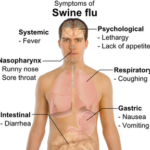The H1N1 virus, also known as ‘swine flu’ is a type of influenza virus that was first detected in people in the United States in April 2009. Since it was discovered in the United States, the virus has spread to several regions of the country and has also appeared in several regions overseas. By June 2009, the World Health Organization informed the public that the 2009 H1N1 flu had reached the level of a pandemic. But how does the H1N1 spread? Here’s a close look at some H1N1 facts and how the virus spreads in humans.
How the H1N1 Spreads
Flu.gov, a website managed by the U.S. Department of Health and Human Services, states that the H1N1 virus can occur in one of two ways. H1N1 flu can occur through contact with infected pigs or when someone comes in contact with an area that is contaminated with the swine flu virus. Another way that H1N1 spreads is through contact with a person who has contracted the virus.
The U.S. Department of Health and Human Services reports that human-to-human contact has been documented throughout the United States and occurs in the same way as the seasonal influenza virus. This is why it is important for all individuals to wash their hands regularly, be mindful of where they are coughing and sneezing, and to stay away from other people if they are showing symptoms of the flu. (Source: PandemicFlu.gov)
H1N1 Facts
There are several misconceptions about the H1N1 virus, and since it is contagious, the Center for Disease Control in the United States has been actively working with medical centers around the country to isolate any outbreaks. Some of the most important H1N1 facts to keep in mind are:
1. The H1N1 virus cannot be contracted by eating pork. Some people believe they can get the H1N1 virus simply by eating pork products, but the Centers for Disease Control and Prevention reports that this is not possible. However it is still important to cook the pork to an internal temperature of at least 160 °F to kill off any bacteria and all types of viruses.
2. Anyone who has contracted swine flu must see a doctor and have a respiratory specimen taken for CDC testing.
3. There is no treatment or vaccine available for humans with the H1N1 virus at this time.
4. Children, the elderly and those with compromised immune systems may be contagious for longer than 7 days if they contract swine flu, say the experts at the U.S. Department of Health and Human Services.
5. Symptoms of the H1N1 virus are similar to those of regular seasonal influenza, which includes a fever, lack of appetite, sore throat and fatigue, reports the Washington State Department of Health.
Sources:
U.S. Department of Health and Human Services: Swine Flu Information
Centers for Disease Control and Prevention: Key Facts About Swine Flu
Washington State Department of Health: Swine Flu Facts






